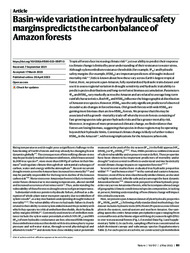Basin-wide variation in tree hydraulic safety margins predicts the carbon balance of Amazon forests.
Basin-wide variation in tree hydraulic safety margins predicts the carbon balance of Amazon forests.
Author(s): TAVARES, J. V.; OLIVEIRA, R. S.; MENCUCCINI, M.; SIGNORI-MÜLLER , C.; PEREIRA, L.; DINIZ, F. C.; GILPIN, M.; ZEVALLOS, M. J. M.; SALAS YUPAYCCANA, C. A.; ACOSTA, M.; PÉREZ MULLISACA, F. M.; BARROS, F. de V.; BITTENCOURT, P.; JANCOSKI, H.; SCALON, M. C.; MARIMON, B. S.; MENOR, I. O.; MARIMON JUNIOR, B. H.; FANCOURT, M.; CHAMBERS-OSTLER, A.; ESQUIVEL-MUELBERT, A.; ROWLAND, L.; MEIR, P.; COSTA, A. C. L. da; NINA, A.; SANCHEZ, J. M. B.; TINTAYA, J. S.; CHINO, R. S. C.; BACA, J.; FERNANDES, L.; CUMAPA, E. R. M.; SANTOS, J. A. R.; TEIXEIRA, R.; TELLO, L.; UGARTECHE, M. T. M.; CUELLAR, G. A.; MARTINEZ, F.; ARAUJO-MURAKAMI, A.; ALMEIDA, E.; CRUZ, W. J. A. da; PASQUEL, J. del A.; ARAGÃO, L.; BAKER, T. R.; CAMARGO, P. B. de; BRIENEN, R.; CASTRO, W.; RIBEIRO, S. C.; SOUZA, F. C. de; COSIO, E. G.; CARDOZO, N. D.; SILVA, R. da C.; DISNEY, M.; ESPEJO, J. S.; FELDPAUSCH, T. R.; FERREIRA, L.; GIACOMIN, L.; HIGUCHI, N.; HIROTA, M.; HONORIO, E.; HUASCO, W. H.; LEWIS, S.; FLORES LLAMPAZO, G.; MALHI, Y.; MONTEAGUDO MENDOZA, A.; MORANDI, P.; MOSCOSO, V. C.; MUSCARELLA, R.; PENHA, D.; ROCHA, M. C.; RODRIGUES, G.; RUSCHEL, A. R.; SALINAS, N.; SCHLICKMANN, M.; SILVEIRA, M.; TALBOT, J.; VÁSQUEZ, R.; VEDOVATO, L.; VIEIRA, S. A.; PHILLIPS, O. L.; GLOOR, E.; GALBRAITH, D. R.
Summary: Tropical forests face increasing climate risk1,2, yet our ability to predict their response to climate change is limited by poor understanding of their resistance to water stress. Although xylem embolism resistance thresholds (for example, Ψ50) and hydraulic safety margins (for example, HSM50) are important predictors of drought-induced mortality risk3,4,5, little is known about how these vary across Earth?s largest tropical forest. Here, we present a pan-Amazon, fully standardized hydraulic traits dataset and use it to assess regional variation in drought sensitivity and hydraulic trait ability to predict species distributions and long-term forest biomass accumulation. Parameters Ψ50 and HSM50 vary markedly across the Amazon and are related to average long-term rainfall characteristics. Both Ψ50 and HSM50 influence the biogeographical distribution of Amazon tree species. However, HSM50 was the only significant predictor of observed decadal-scale changes in forest biomass. Old-growth forests with wide HSM50 are gaining more biomass than are low HSM50 forests. We propose that this may be associated with a growth?mortality trade-off whereby trees in forests consisting of fast-growing species take greater hydraulic risks and face greater mortality risk. Moreover, in regions of more pronounced climatic change, we find evidence that forests are losing biomass, suggesting that species in these regions may be operating beyond their hydraulic limits. Continued climate change is likely to further reduce HSM50 in the Amazon6,7, with strong implications for the Amazon carbon sink.
Publication year: 2023
Types of publication: Journal article
Unit: Embrapa Eastern Amazon
Observation
Some of Embrapa's publications are published as ePub files. To read them, use or download one of the following free software options to your computer or mobile device. Android: Google Play Books; IOS: iBooks; Windows and Linux: Calibre.
Access other publications
Access the Agricultural Research Database (BDPA) to consult Embrapa's full library collection and records.
Visit Embrapa Bookstore to purchase books and other publications sold by Embrapa.

